-
-
A Quick Cantor,
The Early Days of Recording Jewish Music
- by
Paul Vernon. Originally published in folkROOTS.
Copyright belongs to the author. Used by permission.
Edited for LaddersOfSong.com by Jordan Lee Wagner.
- Chief
among the alien throngs which the tide of immigration brings
annually to our shores is the European Hebrew, who has found
in America, "The Land of Promise", opportunity and freedom.
It is a well-known fact that he is one of the chief
patrons and devotees of the musical art. The Jew comes
by inheritance into the place he holds in the field of music
today; for centuries his music and religion have been interwoven.
The Dealer enjoys a unique position in being able to cater
to the needs of the Jewish public today, for the Hebrew-Yiddish
catalog offers a selection of records and artists which
cannot be duplicated.
-
The
Voice of the Victor, (U.S. trade magazine) - February
1922.
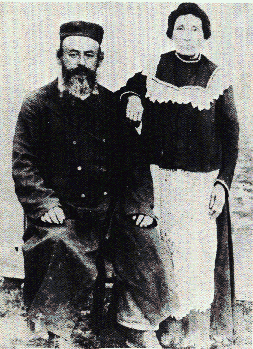 If
we step back thirty years from this clumsily-worded advice,
and shift the scene to the port of Odessa, on Russia's Black
Sea, we can find the audience for whom these records were
intended. From across Russia they were gathering at
the docks, clutching their belongings and tickets to the New
World. They had good reason to want to leave. Czarist
persecution was squeezing the non-Christian population from
its homelands, a proletariat revolution seemed an impossible
dream, and whilst America was not, by any means, the only
option open to them, it was the major one. If
we step back thirty years from this clumsily-worded advice,
and shift the scene to the port of Odessa, on Russia's Black
Sea, we can find the audience for whom these records were
intended. From across Russia they were gathering at
the docks, clutching their belongings and tickets to the New
World. They had good reason to want to leave. Czarist
persecution was squeezing the non-Christian population from
its homelands, a proletariat revolution seemed an impossible
dream, and whilst America was not, by any means, the only
option open to them, it was the major one.
If
they got through the bureaucratic hurdles awaiting them at
Ellis Island --- many were turned back on medical grounds
--- then the 'New Life' and its attendant culture-shock thrust
them into a sink-or-swim environment as challenging in its
own very different way as the one they had so recently abandoned.
Russian-Jewish
success in America was swift, spectacular and very high profile.
Stephen Birmingham's excellent study, The Rest Of
Us, charts this progress in some detail. Within
a generation, Russian Jews had not only merged into the fabric
of American life, they were busy weaving their own patterns.
With this success came the opportunity to own all that
had been dreamed of in the Old Countries, and much that had
been beyond imagination. In the first years of
the 20th century, America offered many affordable status symbols,
but one that captured every imagination was the Phonograph.
- "To
the non-Jewish dealer who has not specialized in foreign
language business, a word of explanation may not come amiss.
We may divide the Jewish record list into two classes:
sacred and secular. The sacred numbers, which are
a part of synagogue worship, are sung in the traditional
Hebrew tongue. In the synagogue the prayers are not
read but chanted, by the Chazan or Cantor, very often with
responses by the choir. The dealer in Victor products
is able to offer his clientele the records of Cantor Joseph
Rosenblatt, whose prominence in the orthodox Hebrew Church
makes his name a household word among his co-religionists".
-
---
The Voice Of Victor
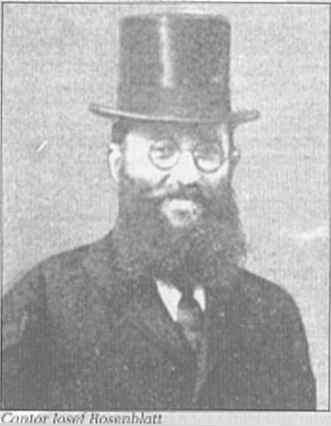 Cantor
Rosenblatt was a remarkable man by any standards. Born
in Byela Tzerkov, Ukraine, in 1882, he toured Russia with
his 'baal t'fillah' (preceptor) father, absorbing chassidic
traditional music. By the age of nine, the boy --- now
known affectionately as 'Yossele' --- was something of a celebrity,
able to sing whole passages from the liturgy without reference.
At eighteen he was appointed to the position of cantor
in Munkaz, Hungary. As his career blossomed, he moved
to Pressburg, in Austria, winning his position in that city's
synagogue by beating over fifty other candidates in what amounted
to a sing-off. While studying in nearby Vienna to polish
his art, the Edison Record Company recorded him in 1905. It
is one of the earliest examples of cantorial singing. The
following year he made a cultural leap into Western European
orthodoxy by taking up an appointment in the Kohlhoefen Synagogue
in Hamburg, where, if we can believe the legend, a rising
Italian tenor named Caruso visited Kohlhoefen specifically
to hear Rosenblatt sing. Cantor
Rosenblatt was a remarkable man by any standards. Born
in Byela Tzerkov, Ukraine, in 1882, he toured Russia with
his 'baal t'fillah' (preceptor) father, absorbing chassidic
traditional music. By the age of nine, the boy --- now
known affectionately as 'Yossele' --- was something of a celebrity,
able to sing whole passages from the liturgy without reference.
At eighteen he was appointed to the position of cantor
in Munkaz, Hungary. As his career blossomed, he moved
to Pressburg, in Austria, winning his position in that city's
synagogue by beating over fifty other candidates in what amounted
to a sing-off. While studying in nearby Vienna to polish
his art, the Edison Record Company recorded him in 1905. It
is one of the earliest examples of cantorial singing. The
following year he made a cultural leap into Western European
orthodoxy by taking up an appointment in the Kohlhoefen Synagogue
in Hamburg, where, if we can believe the legend, a rising
Italian tenor named Caruso visited Kohlhoefen specifically
to hear Rosenblatt sing.
Rosenblatt
visited New York in 1912 as a guest of the Congregation Ohab
Zedek who promptly engaged him as their permanent cantor at
a salary considerably higher than any professional cantor
had ever been paid. The Victor Company recorded him
the following year, Columbia poached him in 1914 and Victor
tempted him back in 1920. His American success was enduring
and he became a much admired public figure. A close
inspection of the pioneering 1927 sound film, The Jazz
Singer, reveals Rosenblatt in glorious voice singing Kol
Nidre (All Vows) and Yahrzeit (In Memoriam). Tragedy,
however, was waiting for him just down the line. During
the early 1920s Rosenblatt had sponsored a Jewish newspaper
that, by 1925, had failed, leaving serious debt in its wake.
In order to clear the debts of honour that weighed upon his
conscience, he bizarrely undertook a massive tour of the American
Vaudeville circuit and immediately followed it up by embarking
on a world tour. 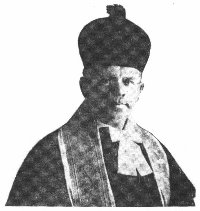 Six
years into this strenuous schedule, while participating in
a film being made in Palestine in 1933, he suffered a fatal
heart attack. Buried on the Mount of Olives in Jerusalem,
prayers were chanted at his funeral by two other legendary
Cantors --- Mordecai Hershman [photo below] and Sawel Kwartin
[photo to right]. Six
years into this strenuous schedule, while participating in
a film being made in Palestine in 1933, he suffered a fatal
heart attack. Buried on the Mount of Olives in Jerusalem,
prayers were chanted at his funeral by two other legendary
Cantors --- Mordecai Hershman [photo below] and Sawel Kwartin
[photo to right].
Although
over sixty Cantors had the opportunity to leave the recorded
examples of their art before the middle of the century, it
was arguably Rosenblatt, Hershman and Kwartin who left the
deepest impressions on the collective Jewish-American conscience.
Coincidentally,
they were also the only three Cantors who began their recording
careers in Europe and then moved to the United States. 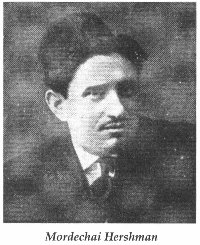 All
the early American Cantors were first-generation emigres into
the New World, and their roots are both pure and clearly evident.
To listen today to their repertoire is both surprising
and revealing, for they sang not only pure liturgical music
but also traditional folk song. It is a genre in which
Hershman, especially, excelled. His version of Die
Negidim un die Kabzonim (Rich Folk, Poor Folk) --- which
can be heard on Cantors & Cantorial, Pearl GEMM9313 --- is
both beautifully performed and very pure in approach. The
lyric is biting in its observations: All
the early American Cantors were first-generation emigres into
the New World, and their roots are both pure and clearly evident.
To listen today to their repertoire is both surprising
and revealing, for they sang not only pure liturgical music
but also traditional folk song. It is a genre in which
Hershman, especially, excelled. His version of Die
Negidim un die Kabzonim (Rich Folk, Poor Folk) --- which
can be heard on Cantors & Cantorial, Pearl GEMM9313 --- is
both beautifully performed and very pure in approach. The
lyric is biting in its observations:
- "Bread
for the rich is a freshly baked roll,
- and
a dry crust for the poor.
- Meat,
for the wealthy, is a roast duckling,
- but
for the impoverished, liver and lights.
- For
the well-to-do, fish is a freshly caught carp,
- but
a soused herring for the paupers.
- Fine
things are rich sweetmeats for the rich
- while
for the needy - a sour gherkin".
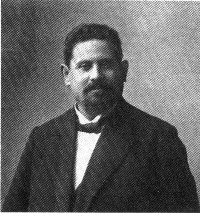 There
was, however, some Cantorial recording activity in Europe
also. Chief among the Old World artists was the legendary
Gershon Sirota. Although he toured the United States
extensively and regularly between 1912 and 1927, he always
returned home to Warsaw; and he may possibly have been the
first Cantor ever to record, for he made cylinders in Europe
during 1902. A glittering career included performances
in Moscow and St. Petersburg, recordings in London, and nineteen
years as chief Cantor at Warsaw Synagogue. He was there
in 1939 when Germany invaded Poland, and Sirota stayed on,
conducting regular services in the Warsaw Ghetto. Tragically,
he perished there in 1943 along with his entire family. There
was, however, some Cantorial recording activity in Europe
also. Chief among the Old World artists was the legendary
Gershon Sirota. Although he toured the United States
extensively and regularly between 1912 and 1927, he always
returned home to Warsaw; and he may possibly have been the
first Cantor ever to record, for he made cylinders in Europe
during 1902. A glittering career included performances
in Moscow and St. Petersburg, recordings in London, and nineteen
years as chief Cantor at Warsaw Synagogue. He was there
in 1939 when Germany invaded Poland, and Sirota stayed on,
conducting regular services in the Warsaw Ghetto. Tragically,
he perished there in 1943 along with his entire family.
All
the Cantors who recorded in America were originally Russian.
Few examples of the German tradition were ever recorded,
with the exception of Hermann Fleischman. His ultimate
fate remains undiscovered; the recordings of this Cologne-based
Oberkantor --- beautiful examples of the art --- were suddenly
deleted from German recorded catalogues in 1934, along with
all other Jewish records. (By 1934-5, the Nazi party
had successfully infiltrated the German record industry and
embarked upon an 'aryanisation' of the catalogues.) An
elder statesman at the time of recording, Fleischmann's style
is archaic, formal, and lacking in the improvisational skill
of a Rosenblatt or a Hershman. It is also stunning in
its purity, and historical perspective allows us now to see
how valuable was the preservation of such singing by the Parlophon
record company.
The
tradition, of course, remains unaltered. Cantorial singing
may be heard all across the world in any community that supports
a synagogue; and contemporary recordings --- many of them
on small, semiprivate labels --- are both available and worth
finding.
Thus
the art of the Cantor, still a relevant tradition with age-old
roots based firmly in a vibrant culture, may arguably be seen
as the spiritual side of the folk-based coin that also gives
us Klezmer music. Whilst some traditional voices raised
objection to the 'sin' of secular dancing and singing, many
Jews grew up in an environment that included both the Talmudic
chant and the good-time stomp of a bulgar.
- "Secular
numbers are sung or spoken in Yiddish. Although looked
down upon by philologists and Hebrew scholars, this so-called
jargon has been the recognised speech of most of the Jews
throughout the world. The Victor Jewish list is replete
with instrumental numbers, including many popular traditional
numbers played by Kandell's Orchestra, Elenkrig's Orchestra,
Stupel's Orchestra and Rumshisky's Orchestra"
-
---
Voice Of Victor
Victor
didn't call these records Klezmer; in fact at that time very
few people did, but that's exactly what they were.  To
be pedantic, they were largely 'modem' Klezmer, reflecting
the experience of the new world as well as nostalgia for the
old... To
be pedantic, they were largely 'modem' Klezmer, reflecting
the experience of the new world as well as nostalgia for the
old...
The
term 'Klezmer' itself derives from the Hebrew words 'klei
zemer', which, as Henry Sapoznik in The
Compleat Klezmer points out, originally referred
to the instruments themselves rather than the musicians...
...As
a result of the Russian pogroms, America experienced two major
waves of Russian-Jewish immigration, just before the century
turned and again just after. By good fortune, these
events coincided with the emergence of the new entertainment-oriented
technologies, the moving picture and the phonograph.
In 1904, as the second migratory wave was settling into East
Side New York, the Jewish newspaper Forward editorialized;
"God
sent us the Victrola and you can't get away from it, unless
you run to the park. As if we didn't have enough problems
with cockroaches and children practising the piano next door...
It's everywhere this Victrola: in the tenements, the
restaurants, the ice-cream parlours, the candy stores. You
lock your door at night and are safe from burglars but not
from the Victrola."
 Naturally
enough, people wanted something relevant to their own culture
to play on this new machine. Since the companies who
sold the phonographs also manufactured the records that were
played on them, they were keen to record whatever people wanted
to hear. Naturally
enough, people wanted something relevant to their own culture
to play on this new machine. Since the companies who
sold the phonographs also manufactured the records that were
played on them, they were keen to record whatever people wanted
to hear.
At
first, Victor concentrated on selling large quantities of
their famous 'Red Seal' opera records to the Jewish community,
in the --- largely correct --- belief that a Russian Jew would
buy 'good' music in the same way that an Italian or German
would. To the Victor Company (and its major rival, Columbia)
all immigrants represented 'foreign trade' and it took a while
before they began to realise that vernacular records with
a folk-based root would sell at least as well as an aria or
a cornet solo. As the 'opera boom' faded somewhat, during
the teens, the record companies began to cast around for the
Next Big Thing.
 A
cautious and somewhat haphazard programme of 'Foreign' recording
that had been undertaken by all the record companies almost
as soon as the phonograph was first marketed, now took off
in every direction. With the European War behind it,
a booming economy beckoning it forward, and Volstead's infamous
Prohibition Act to add spice to everyone's life, America prepared
for the blossoming of its capitalist ideals. A
cautious and somewhat haphazard programme of 'Foreign' recording
that had been undertaken by all the record companies almost
as soon as the phonograph was first marketed, now took off
in every direction. With the European War behind it,
a booming economy beckoning it forward, and Volstead's infamous
Prohibition Act to add spice to everyone's life, America prepared
for the blossoming of its capitalist ideals.
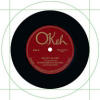 By
1920 all the company's 'Foreign' lists had significantly expanded.
Immigrant sensibility was suddenly big business. Columbia,
Edison, Okeh, Pathe and Victor all geared up to compete with
one another for the 'new' market. It was Victor, however,
who pursued this course most aggressively. From about
1919 until the Depression started to take hold in 1931-32
they targeted almost every identifiable ethnic group with
specifically tailored record lists. Because it was convenient,
they classed Jews as a racial group, largely oblivious of
the social differences between the 'older' German populace
and the late-arriving Russians. By
1920 all the company's 'Foreign' lists had significantly expanded.
Immigrant sensibility was suddenly big business. Columbia,
Edison, Okeh, Pathe and Victor all geared up to compete with
one another for the 'new' market. It was Victor, however,
who pursued this course most aggressively. From about
1919 until the Depression started to take hold in 1931-32
they targeted almost every identifiable ethnic group with
specifically tailored record lists. Because it was convenient,
they classed Jews as a racial group, largely oblivious of
the social differences between the 'older' German populace
and the late-arriving Russians.
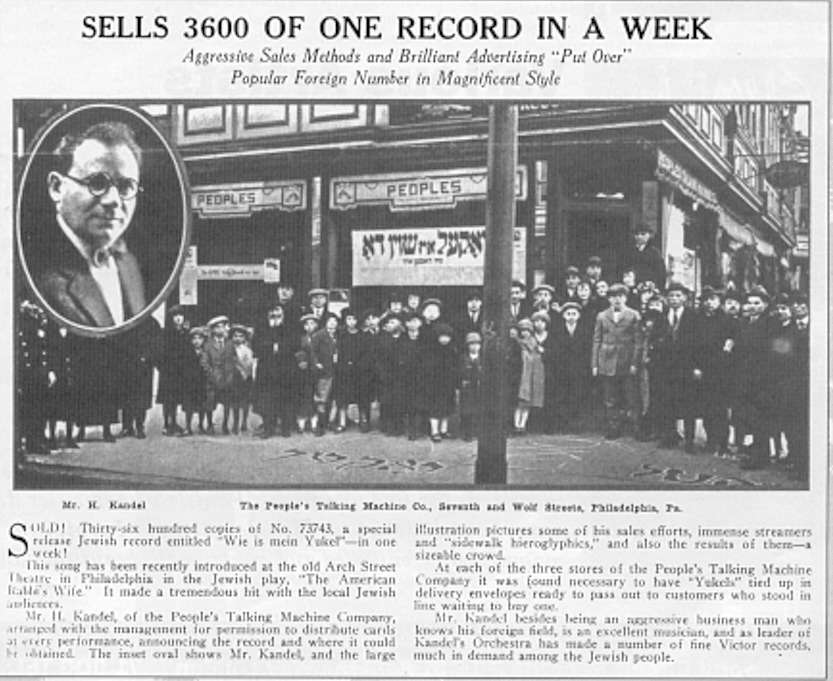
SELLS 3600 OF ONE RECORD IN A WEEK
Aggressive Sales Methods and Brilliant Advertising "Put Over"
Popular Foreign Number in Magnificent Style
SOLD!
Thirty-six hundred copies of No. 73743, a special release
Jewish record entitled 'Wie is mein Yukel" in one Week!
This
song has been recently introduced at the old Arch Street Theatre
in Philadelphia in the Jewish play, "The American Rabbi's
Wife". It made a tremendous hit with the local Jewish
audiences.
Mr.
H. Kandel, of the People's Talking Machine Company, arranged
with the management for permission to distribute cards at
every performance, announcing the record and where it could
be obtained. The insert oval shows Mr. Kandel, and the
large illustration pictures some of his sales efforts, immense
streamers and "sidewalk hieroglyphics," and also the results
of them a sizeable crowd.
At
each of the three stores of the People's Talking Machine Company
it was found necessary to have "Yukels" tied up in delivery
envelopes ready to pass out to customers who stood in line
waiting to buy one.
Mr.
Kandel besides being an aggressive business man who knows
his foreign field, is an excellent musician, nd as leader
of Kandel's Orchestra has made a number of fine Victor records,
much on demand among the Jewish people.
A
few Klezmer Orchestras were appearing while the Great War
was still being fought in Europe, and one of these, Kandell's
Orchestra, turned out to be perhaps the best-loved of all
American Klezmer bands. Harry Kandell was 32 years old
when he and his dozen-strong group first entered the Victor
studios in November 1917. A Freilachs Von Der Chuppe
(A Happy Dance from the Wedding Ceremony) clearly caught the
public's attention and brought the Kandell band back to record
more sides just a few weeks later. The sound that Kandell's
Orchestra produced was definitely 'modern'. Whilst the
traditional Klezmer instrument, the violin, was still present,
it was Kandell's clarinet that led the melody, and arguably
he broke the ground for those who would follow by establishing
an essentially 'American' Klezmer style.
Kandell's
records sold in considerable quantities. While sales
figures appear not to have survived, it is clear from the
frequency with which he was recorded, and the fondness with
which he is remembered, that Kandell's success had a number
of profound effects. Apart from popularizing the clarinet
as a preferred melodic instrument, the public's enthusiastic
consumption of his records sent the record companies out looking
for more like him.
The
people they found were legion. Some 700 Klezmer records
were issued in the United States before the 1942 Musicians
Union ban on recording, mostly during the period 1920-29.
The lead established by Kandell was quickly followed
by Abe Schwartz, Naftule Brandwein, Joseph Cherniavsky and
others who formed orchestras based largely upon the same instrumentation.
Still, no-one was calling it 'Klezmer', except perhaps
in private circles. The term was viewed as too 'Old
World'. Previewing a 1924 Naftule Brandwein release
the Victor company sidestepped the term quite markedly;
"Here's
speed for you! Observe the swiftness of this remarkable
music, the clarity and ingeniousness of the melodies that
come so rapidly from Naftule Brandwein's musicians, and you
will be thrilled. The selections on this record are
highly original and out of the ordinary, and will give you
a new idea of the excellence of this musical organisation.
Both feature wonderful clarinet playing and both are
remarkably fine dance records."
...When
times got hard in the early 1930s and the record companies
cut back their catalogues, almost the first things to go ---
before even the Blues or Gospel records --- were the ethnic
lists. In 1932 Columbia deleted almost everything in
its 'foreign' catalogues, Victor cut back drastically and
other smaller companies either folded or were swallowed up
in mergers. As America climbed slowly out of the depression
through the '30s, recording began again but there was a marked
absence of traditional old-time Klezmer. Many theories
have been suggested, some argue that Klezmer was a first-generation
music, and that by the mid-'30s second generation Jews were
more interested in Swing. Others theorised that the
Russian Jewish emigres consciously rejected the old world
cultures in an attempt to assimilate into American society,
but the most likely answer is that it was both these reasons
and more besides. The 1920s had been a golden age for
recording of all kinds right across the world. It was
the decade in which popular recorded music first really blossomed
and a wide overview reveals a pattern of commercial readiness
to record anything. By the middle of the following decade,
the industry had gained some measure of maturity and already
it was less keen to experiment quite so wildly. There
is already evidence of the 'formula' attitude among the major
companies that would, a few years later, lose them the ethnic
markets altogether. A postwar return to independent
local product occured within almost every immigrant group
in the U.S.A. after 1944, just as it did in Blues and Country.
The
current revival of interest in traditional Klezmer dates back
to the late 1970s with the emergence of the Berkeley-based
Klezmorim band and the independent producer Chris Strachwitz's
willingness to record them. Followed closely on the
East Coast by Henry Sapoznik's Kapelye and the Klezmer Conservatory
Band, and bolstered by well-crafted reissues of original recordings
on Global Village and Folklyric, Klezmer now enjoys its rightful
position within the folk-roots world. I would now humbly
suggest that the same recognition be awarded to another great
Jewish folk tradition --- the art of the Cantor.
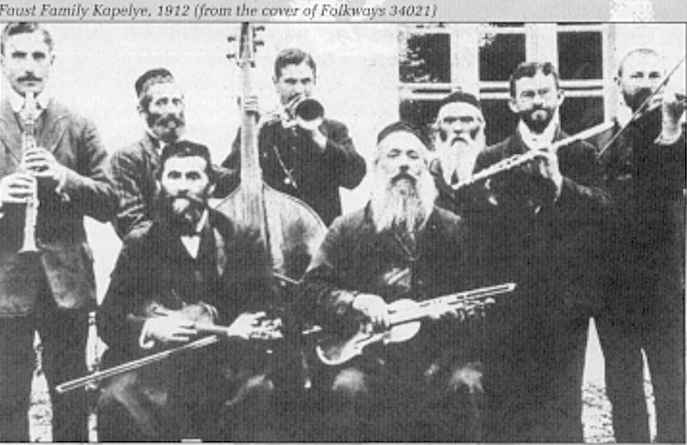
On
CD:
Cantors:
Claremont
785030 Legendary Cantors
Pearl
GEMM9313 Cantors & Cantorials 1 904-36
Symposium
1044 Great Cantors 1093-30
Start
with any one and you'll end up getting them all. First
rate compilations with full descriptive notes.
Klezmer:
Rounder
1089 Klezmer Pioneers 1905-52
Yazoo
7001 Dave Tarras 1925-56
The
Yazoo features Tarras in a number of settings and offers good
examples of seminal recordings by important orchestras. The
Rounder is an excellent compilation also.
Cassette
and vinyl:
Both
the Rounder and Yazoo CDs are on tape, and the following,
while perhaps difficult to locate, are worth looking for:
Folklyric
9034 Klezmer 1910-27- a fine introduction to the genre.
Folkways
34021 Klezmer- early recordings 1910-42, with excellent notes
by Henry Sapoznik
Global
Village 101 Jackie Jazz 'em Up - early Klezmer bands
104
Klezmer 1910-42
105 & 106 Dave Tarras Vols 1 & 2
108 Sid Beckerman
109 Naftule Brandwein
128 Harry Kandell
You
might still find Folklyric 9034 on vinyl where it has fuller
notes than its tape equivalent. The same is true for
Folkways 34021. If you haunt secondhand stores, look
for old albums on the U.S. Jewish Music Archives label ---
they issued the early recordings of Rosenblatt, Kwartin and
others in the '60s.
Reading:
For
Klezmer, Henry Sapoznik's The Compleat Klezmer (Tare publications,
NY) is about the only reliable source.
For
Cantors there is little, but you will get a good deal of information
out of the liner notes to the Claremont, Pearl and Symposium
CDs. Stephen Birmingham's The Rest Of Us - The Rise
Of America's Eastern European Jews (Future paperbacks)
provides an excellent in depth background and social context.
With
thanks to: National Sound Archive, British Library, Music
Library and my great-grandfather for his timely departure
from Czar Alexander's regime.
|
Cantors...
|



